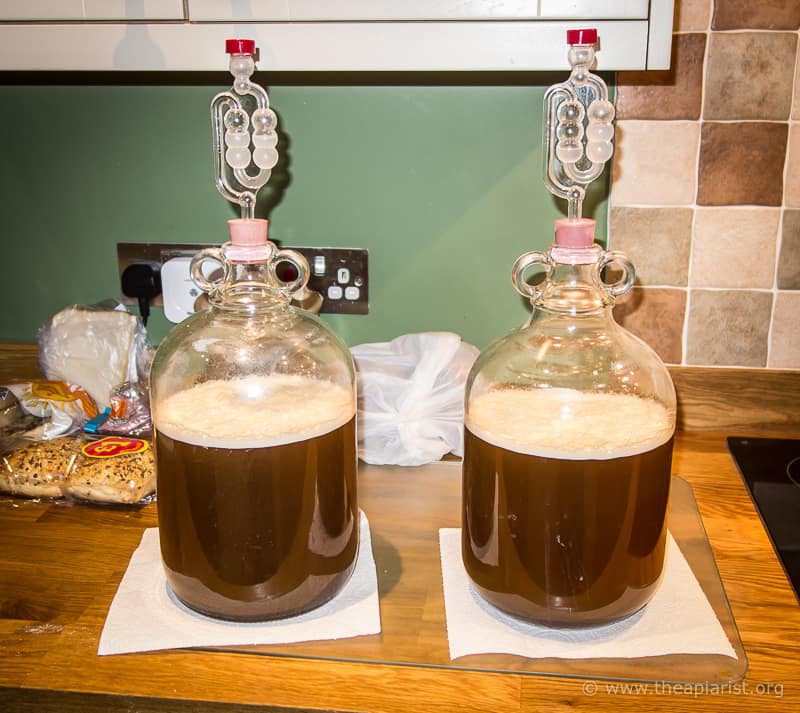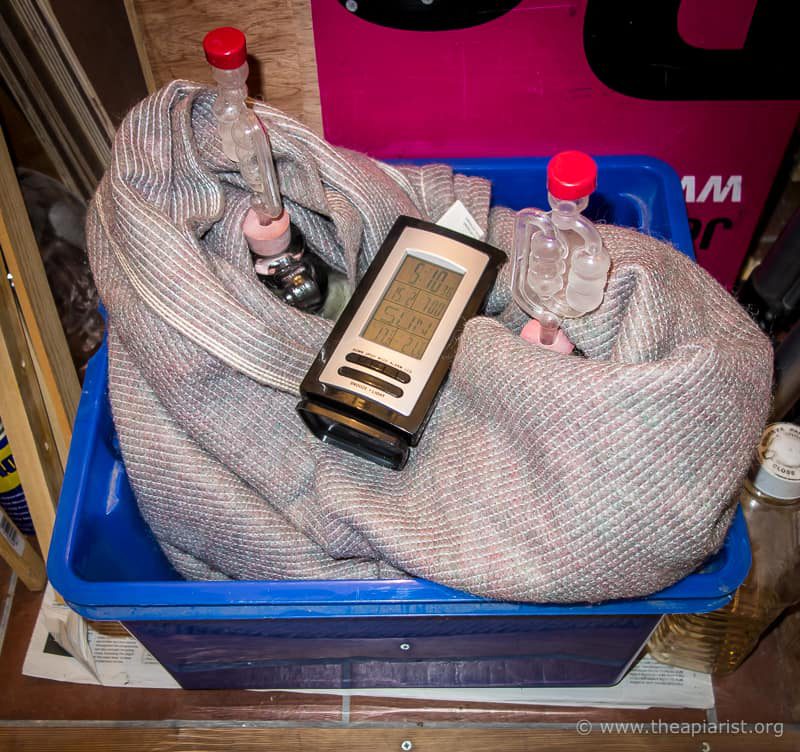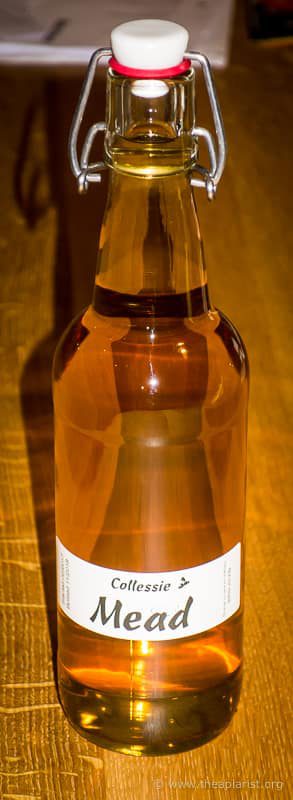Making mead
Every year, usually around Christmas, I make a batch of mead.
About a year later I bottle the mead and leave it to mature.
A year or more later I start drinking the mead … if it’s drinkable 😉
If at first you don’t succeed …
The last couple of batches have been, if not spectacular, certainly very drinkable.
I expect them to improve further with age {{1}} and so have tucked them away for special occasions over the next 12-18 months … or longer {{2}}.
Clearly this isn’t a quick process.
The early batches I made were pretty rough. Some were ditched at – or rather just before – bottling. However, I’ve now settled on a recipe (which means found … I claim no originality for it) that has worked well for at least three batches in a row.
Here it is.
Equipment
You’ll need a small amount of equipment, all of which is readily available from a brewing and winemaking store. I’ve used Hop and Grape, but there is lots of choice online. In England, Wilkinsons is also a good source of inexpensive brewing supplies.
- Demijohn
- Airlock
- Rubber bung
- Siphon (or simple piece of tubing)
- Bottles
- Good sized saucepan
- Funnel
Recipe
- ~4lb of well-flavoured honey
- 1 mug of cold tea
- 1 teaspoon of citric acid
- 1 teaspoon of yeast nutrients
- 5g of good quality white wine yeast. I’ve had the most success with Lalvin D47.
- 5 litres of still bottled water
Preparation
- Prepare a mug of tea. Use boiling water and one tea bag, leave it to go cold and discard the tea bag. While it’s cooling prepare the yeast starter and sterilise everything.
- Add the yeast to a clean glass containing 100ml or so (quantity isn’t critical) of warm water at ~40°C. Stir to disperse the yeast and leave at room temperature to rehydrate.
- Add the honey to the saucepan and add about 2 pints of water. Warm over a gentle heat, stirring regularly to completely dissolve the honey. It doesn’t need to get hotter than ‘hand hot’. Once the honey is completely dissolved take the saucepan off the heat and allow to cool. While that’s happening prepare the demijohn.
- Thoroughly sterilise a demijohn. I use crushed Campden tablets as I’m ‘old skool’, there are probably newer and better ways to do this now. At the same time sterilise a rubber bung for the demijohn, a funnel and an airlock. Rinse the cleaned demijohn very well (tap water) and then add ~1 pint of bottled water.
- To this demijohn, using the funnel, add the honey mix, the cold tea, citric acid and the yeast nutrients. The temperature should now be around 30°C.
- Add the yeast starter. There will still be a considerable volume of the demijohn still empty (see the image above).
- Add the bung and, holding the bung tightly in place, shake the demijohn very vigorously.
- More, shake it some more. I don’t know if it really helps, but it feels like you’re doing something important and constructive 😉
- Replace the bung with an airlock part-filled with bottled water.
- Place the demijohn somewhere out of the way to ferment. The temperature (at least for Lalvin D47) needs to be 15-20°C but not any higher or it can produce ‘off’ flavours. I wrap the demijohn in bubble wrap or old blankets to help keep the temperature stable {{3}}. It needs to be out of the way as you don’t want to move it and disturb things during fermentation.
- Bubbles will start in 6-18 hours. Initial fermentation can be very vigorous which is why lots of headspace was left at the beginning.
- After 48-72 hours fermentation will have steadied to about one bubble every few seconds. The sound is hypnotic 🙂 Once fermentation has steadied remove the airlock, top up with water to within 1″ of the neck of the demijohn and replace the airlock.
- Let fermentation continue. After 2-3 months fermentation will have almost or completely stopped. The demijohn will have a thick layer of yeast settled at the bottom of the bottle.
- Avoiding the yeast layer, siphon the mead into a new, sterilised demijohn. Don’t disturb the yeast layer … don’t worry about not getting every last drop out of the demijohn.
- Top up the new demijohn with ~1:3 w/w honey in warm water (i.e. 227g of honey dissolved in 750ml of water). Replace the airlock. Fermentation will start again.
- Once fermentation has completely finished – this takes a variable length of time – the mead should be crystal clear {{4}}.
- Bottle the mead. Test it (of course!) and leave it somewhere dark and cool to mature for several months.
Additional notes and comments
This is a very basic guide to making mead. That’s because, despite making it for a few years, I’m still very much a beginner. There are hundreds of guides and at least as many recipes online. Read a few, but then just have a go … don’t get bogged down in the minutiae. If you can’t find Lalvin D47 use generic white wine yeast.
Use well-flavoured honey. Don’t use something bland or insipid. Many people use heather honey for mead though the best batches I’ve made have always been with a good midsummer mixed floral honey.
Using the recipe above the last few batches have cleared perfectly. One or two early attempts remained cloudy after racking it off and I remedied this by adding a bit of bentonite.
I’m a bit of a heathen and usually use 500ml “Grolsch-type” bottles, which are more properly termed swing-top bottles. If you’re intending to compete in your association annual honey show make sure you use the correct type of bottle … which will not be a swing top 😉
Whatever bottle style you use make sure it is made of clear glass … you want the lovely golden amber colour of the mead to shine through.
I’ve no idea of the alcohol content as I’ve lost my hygrometer. Lalvin D47 can tolerate 14-16% alcohol which gives you an idea of the upper limit it will reach.
I know the stuff I’ve made is reasonably potent. Test your mead in moderation. If you like the flavour I’d recommend NOT guzzling the entire bottle in one sitting … particularly if you use standard volume (75cl) wine bottles {{5}}.
Remember that you can’t sell alcohol without a licence.
Drink it with friends and sell them lots of honey when their defences are lowered 😉
Have fun
{{1}}: Actually, the mead prepared in 2015 has now all gone and was pretty good by the time I gave the last bottle away.
{{2}}: I don’t drink all the mead two years after starting it … it keeps well, gets better with age and is pretty strong!
{{3}}: This might not be needed in a house better insulated than mine i.e. most houses.
{{4}}: I’ve sometimes forgotten it by this stage and it’s stood around for up to 12 months with no apparent ill-effects.
{{5}}: Don’t do as I do, do as I say.



Join the discussion ...